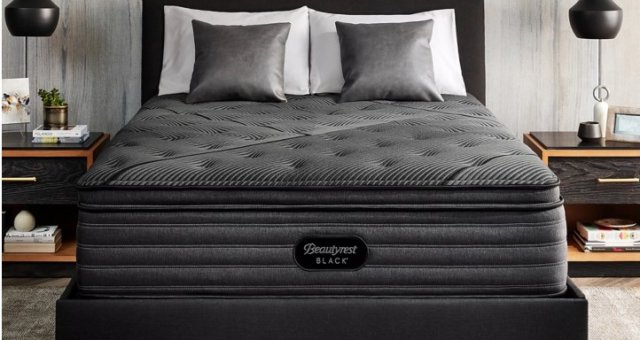When to Replace Your Mattress
Did you know you’ll spend about a third to half of your life sprawled out on your bed? Or that your mattress can have a major impact on whether or not you get sufficient sleep, which is crucial for both your short- and long-term mental and physical health? If not, it’s time you know, so you can give yourself the best shot at getting a good night’s rest every night. And one of the primary ways you can do that is to make sure you’re replacing your sleeping surface at regular intervals.
So, how often should you replace your mattress? Whether firm, soft, synthetic, or natural, all mattresses wear out at some point — some can last a decade or more, while others might only last a few years. And once a mattress ages out of its recommended lifespan, chances are it won’t provide you with the support you need to get a great night’s sleep. While most manufacturers recommend swapping an old mattress for a new one after about eight years, several variables help determine how long any mattress will hold up.
Curious how long your mattress might last? Let’s take a look at the average lifespan of different mattress types, factors that can impact lasting power, and how you can tell when to replace a mattress that’s served you well for years.
Average Life of a Mattress
Generally speaking, most mattresses last somewhere between six and 15 years. However, the lasting power of any mattress depends on several factors, including the materials it’s made from, the quality of its construction, the frequency with which it’s used, and the way it’s cared for.
Ultimately, there’s no hard-and-fast rule for determining how often to replace a mattress since so many variables factor into the amount of wear-and-tear a sleeping surface experiences. That said, here’s a breakdown of ballpark lifespans for the most common mattress types.
Innerspring & Hybrid Mattress
While there are several variations of innerspring mattresses, they’re all constructed with interior coil springs that are typically fashioned from steel. And the quality of each mattress’s spring construction and the type and quality of its surface (double-sided, memory foam, pillow top, gel, or foam encasement) are key factors in determining its longevity. User weight will also have a significant impact on the lasting power of an innerspring mattress — the heavier you are, the faster you’ll wear out the springs with regular use.
On average, innerspring mattresses last seven to 10 years, sometimes longer. The more resilient the coils are and the higher quality the topper is, the more life you can expect to get. If you have a double-sided innerspring mattress — the type you can periodically flip over — there’s a good chance it’ll last longer than a hybrid mattress you can’t flip.
Memory Foam Mattresses
Memory foam mattresses are typically constructed from polyurethane foam that compresses and naturally conforms to the shape of each sleeper’s body. Without the weight of a person, that foam will return to its resting, decompressed state.
Although the foam undergoes repeated compression throughout its life, it tends to have more lasting power than the average innerspring mattress. Quality memory foam generally lasts anywhere from 10 to 15 years with proper care, and the highest-end materials can last even longer.
If you have one of these mattresses, make sure you rotate it regularly to help extend its life. Don’t flip it, just rotate it a quarter- or half-turn on the bed frame to decrease the risk of leaving permanent depressions in a particular area over time. If you have a high body mass index, be especially conscientious about rotations to help prevent your mattress from experiencing premature wear.
Gel Memory Foam Mattresses
These mattresses are similar to standard memory foam but also feature integrated gel swirls or beads that help distribute body heat and provide a cooler sleeping surface. Like their standard counterparts, gel-foam mattresses typically last about 10 to 15 years and can benefit from routine rotations. With proper care, the highest-quality gel-foam materials can last even longer than 15 years. But again, sleeper weight will play a role in the amount of wear-and-tear any gel-foam mattress experiences.
Latex Mattresses
As their name implies, these mattresses are fashioned from synthetic or natural latex foam, which is quite dense and tends to have some serious lasting power. On average, a latex mattress will hold up about 15 years, but models made from super-dense, natural latex may last longer than that.
Because they’re thick and less spongy than memory foam, latex mattresses generally don’t require routine rotation or flipping to prevent permanent depressions. However, if you have one, you can flip and/or rotate it as you please — but doing so may be a bit more work than it’s worth.
How Long Should You Own a Mattress?
Because multiple factors influence the lifespan of any type of mattress, it’s tough to say exactly how long you should own your mattress before you retire it. While you can usually get about a decade of use (give or take a few years) out of a new mattress, the age of your bed won’t necessarily determine the need for a replacement.
What will? The quality of your sleep and the way your mattress wears. Monitor how easy it is for you to fall asleep and stay that way and how you feel upon waking. You’ll also want to pay attention to the look, feel, and smell of your sleeping surface to better determine how often to replace your mattress.
Signs You Need to Replace Your Mattress
If your mattress is relatively new and you wake up feeling oddly hot or generally uncomfortable, chances are you need to replace it. Even if your sleeping surface is just a couple of years old, its level of firmness may not be ideal for your needs. Swapping out a too-plush or too-firm bed for something better suited to your body can help you improve your sleep quality in no time at all.
But if you have an older bed, how do you know if your mattress is worn out? When you notice one or more of the following issues, that’s a good indication it’s time to replace your mattress.
You Sleep Poorly or Consistently Wake Up Sore
When it comes to deciding how often to replace your mattress, consider how well you’re sleeping on it first. If you feel like you’re always tossing and turning, a bad bed — rather than an overstressed brain — might be the culprit. If you feel like you’re consistently suffering from new aches and pains or your existing aches and pains are getting worse, it’s probably time to go mattress shopping. Your tired, sore body will thank you for the upgrade.
Your Allergies Are Getting Worse
Dust mites, bacteria, and all sorts of other microscopic nasties accumulate in your mattress over time, regardless of how well you care for it. And an overabundance of those tiny particles can aggravate your allergies or cause you to develop odd symptoms, such as skin or respiratory irritation, even if you don’t have allergies.
Your Mattress Has Visible Signs of Wear
When your mattress starts to visibly droop or sag, either at the edges or somewhere in the center, it’s time for an upgrade. And if you can see the material is deteriorated or damaged in other ways — significant staining, fraying, tears, etc. — that’s also a sign it’s time for a replacement. Once a mattress has suffered considerable wear, it will only continue to break down, usually at an accelerated rate.
You Instantly Sink When You Sprawl
When you lie on your mattress, do you immediately sink deeper than you’d like to? Do you feel like you’re stuck in a canyon you can’t roll out of? If so, you’re probably due for a replacement. While a mattress should conform to you, regardless of your weight, it should also provide ample support. If it doesn’t, you could end up with spine problems, joint pain, and even postural issues over time.
Your Mattress Smells Odd
If your mattress smells unpleasant, and you can’t eliminate the odor no matter what you try, it’s time to invest in a replacement. In some cases, pungent, chemical-like odors can occur when a mattress’s interior materials gradually break down. Musty odors can also develop if mold or mildew begins growing inside a mattress, which may happen in particularly humid areas or if you tend to sweat a lot while you snooze.
Think it’s time to replace your mattress? Then check out our collection of Ashley Sleep mattresses to find your ideal fit! Whether you’re in the market for a small, medium, or large bed or a mattress that’s plush, firm, or somewhere in between, we carry tons of options to suit virtually any sleeping style or size preference.





